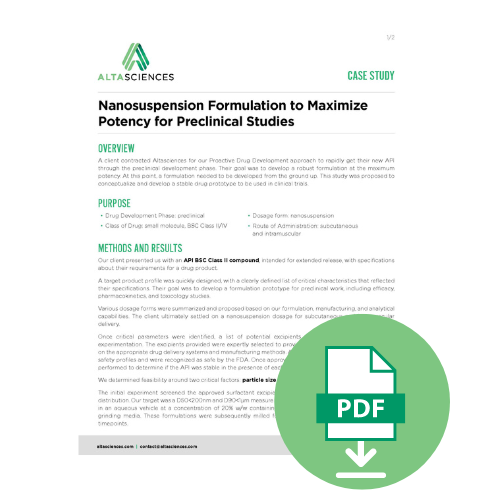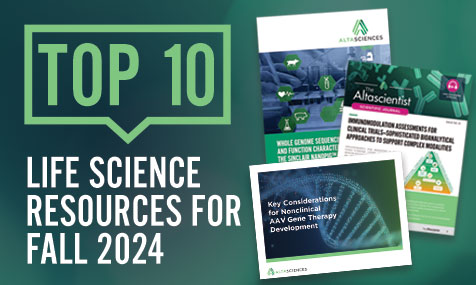Case Study: Innovative Nanosuspension Approach to Maximize API Potency in Preclinical Formulation Development

Each preclinical formulation development program has unique formulation goals; whether it be to maximize potency or bioavailability, to change the drug-release timing, to improve safety and stability, or to provide improved handling characteristics.
If your active pharmaceutical ingredient (API) has challenges in achieving maximum potency due to bioavailability or permeability classification, Altasciences has the expertise to help you overcome that obstacle. Read the case study below to see how we helped a client with preclinical formulation development, maximizing potency with nanosuspension.
Client Study Overview
A client approached us with the need to get their API BSC Class II compound through the preclinical formulation development phase. Their goal was to develop a robust formulation prototype at the maximum potency, for preclinical work, including efficacy, pharmacokinetics, and toxicology studies. We were required to develop a formulation from the ground up. We worked with the client to create a target product profile with a clearly defined list of critical characteristics that reflected their specifications.
We summarized and proposed different options of dosage forms based on our expertise in preclinical formulation development and potency maximization. And from these options, the client selected nanosuspension for subcutaneous and intramuscular delivery for further development.
Excipient Selection
We carefully selected a list of potential excipients with the best estimated results for the appropriate drug delivery systems and manufacturing methods. All excipients listed had well-defined safety profiles and were recognized as safe by the FDA. Once approved, we performed an excipient compatibility study to determine if the API was stable in the presence of each excipient.
Feasibility Determination for Preclinical Formulation Development
We determined feasibility around two critical factors: particle size distribution and concentration.
In our initial experiment, we screened the approved surfactant excipients to best achieve the target particle size distribution of a D50<200nm and D90<1μm measure via laser diffraction. Then we suspended solid API in an aqueous vehicle at a concentration of 20% w/w containing the different surfactants and 0.4mm YTZ grinding media. We milled these formulations for up to 48 hours and sampled them at various timepoints.
We further investigated promising formulations by repeating the milling at incrementally higher API concentrations, up to 40% w/w. We developed analytical methods in parallel, with feasibility experiments for particle size, zeta potential, and assay, in compliance with regulatory requirements. Successful formulations were placed on short-term stability.
Robust, Reproducible, and Scalable Processes for Preclinical Formulation Development
Using the data generated by the lead prototype formulations, we next developed a robust and reproducible process necessary for large-scale manufacturing.
We moved the manufacturing process to our DeltaVita® milling equipment, and enhanced the process parameters (pressure, temperature, homogenization cycle, etc.) to reliably manufacture the nanosuspension. The pilot batch was used to support accelerated and real-time stability studies that determined the long-term stability of the nanosuspension by evaluating the impact of various storage conditions on particle size and API stability.
At the end of the preclinical formulation development process, we produced an optimized, stable nanosuspension for our client’s preclinical studies.
How Altasciences Can Help With Your API Formulation
For challenges with your API due to bioavailability or permeability classification, Altasciences’ preclinical formulation development expertise can help you overcome such issues. We apply all our formulation, manufacturing, and analytical capabilities to meet the target profile of your molecule or compound, including the necessary excipients and different formulation options, for both preclinical studies and later-phase scale-ups.
Using advanced processes, we have formulated, tested, and/or manufactured nearly every pharmaceutical dosage form currently available on the market, including tablets, liquid- and powder-filled capsules, over-encapsulated capsules, nanomilled suspensions, creams, gels, powders, and terminally sterilized injectables.
We have an impressive 99% on-time delivery record and would be happy to discuss your upcoming projects. Contact us today!



